Did you know that the Philippines is home to a remarkable diversity of languages? With approximately 130 to 195 different languages spoken throughout the archipelago, the Philippines boasts a rich tapestry of linguistic diversity. From Filipino languages to regional dialects, indigenous languages to minority languages, the Philippines is a fascinating linguistic landscape waiting to be explored.
But what are these languages? How do they contribute to the country’s cultural heritage? And why is language diversity in the Philippines so significant?
In this article, we will take a deep dive into the different languages spoken in the Philippines, uncovering the major languages, regional dialects, indigenous languages, and minority languages that make up the country’s linguistic mosaic. We will explore the historical and cultural factors that have shaped these languages, the influence of Spanish and English, language policies, the importance of language preservation, and much more.
Join us as we embark on a fascinating journey of discovery, unraveling the linguistic fabric that weaves together the diverse cultural tapestry of the Philippines.
Key Takeaways:
- The Philippines is a linguistically diverse country, with approximately 130 to 195 languages spoken throughout the archipelago.
- These languages include Filipino languages, regional dialects, indigenous languages, and minority languages.
- The major languages in the Philippines include Tagalog (Filipino), Cebuano, Ilocano, and Hiligaynon.
- Regional dialects in the Philippines reflect the diversity of different regions and provinces, such as the Visayan languages and the Bikol languages.
- Indigenous languages play a vital role in preserving the cultural identities of indigenous communities in the Philippines.
Major Languages in the Philippines
The Philippines is a linguistically diverse country, with several major languages spoken across the nation. These languages, including Filipino languages, play a vital role in communication and cultural identity. Let’s explore some of the major languages in the Philippines:
1. Tagalog (Filipino)
Tagalog, also known as Filipino, is the national language of the Philippines. It is based on the Tagalog dialect spoken in the Manila region and serves as a lingua franca among Filipinos. Tagalog is the most widely spoken language in the country and is used in education, media, and government.
2. Cebuano
Cebuano is another major language spoken in the Philippines, particularly in the Visayas and Mindanao regions. It is the second most widely spoken language in the country. Cebuano has its own distinct dialects and is an important language for communication among communities in these regions.
3. Ilocano
Ilocano is a prominent language spoken in the Ilocos region of the Philippines. It has a rich literary tradition and is widely used in the provinces of Ilocos Norte and Ilocos Sur. Ilocano is known for its unique phonology and vocabulary, reflecting the cultural heritage of the Ilocano people.
4. Hiligaynon
Hiligaynon, also known as Ilonggo, is spoken in the Western Visayas region of the Philippines. It is one of the major languages in the Philippines and is widely used in provinces such as Iloilo and Negros Occidental. Hiligaynon has its own distinct features and plays a significant role in the cultural expression of the region.
These major languages in the Philippines, including Tagalog, Cebuano, Ilocano, and Hiligaynon, represent the linguistic diversity and cultural richness of the country. They contribute to the communication, cultural identity, and heritage of different communities in the Philippines.
Regional Dialects in the Philippines
In addition to the major languages, the Philippines boasts a rich tapestry of regional dialects that showcase the cultural diversity and linguistic heritage of different regions and provinces. These regional dialects bring forward unique nuances and identities, forming an integral part of the linguistic landscape in the Philippines.
Visayan Languages
The Visayan languages, including the widely spoken Cebuano, are predominantly found in the Visayas and Mindanao regions of the Philippines. Each region within these areas boasts its own distinct dialect, further emphasizing the diversity within the Visayan language family.
Bikol Languages
The Bikol languages are primarily spoken in the Bicol region of the Philippines. Within this region, several Bikol dialects exist, each shaped by the cultural and historical influences of its local community.
Pangasinan Language
The Pangasinan language is spoken in the Pangasinan province. With its unique phonology, vocabulary, and grammar, the Pangasinan language represents the linguistic heritage of the province and its people.
Kapampangan Language
The Kapampangan language takes center stage in Pampanga and neighboring provinces. Its distinctive features, including its vocabulary, pronunciation, and syntax, highlight the cultural nuances and identity of the Kapampangan-speaking community.
Waray-Waray Language
The Waray-Waray language is predominantly spoken in the Eastern Visayas region of the Philippines. As an Austronesian language, it offers a fascinating glimpse into the culture and history of the Waray-speaking communities.
These regional dialects in the Philippines contribute to the vibrant linguistic tapestry of the country, demonstrating the richness of its cultural heritage. Embracing this diversity fosters a sense of unity and mutual respect among Filipinos, while also highlighting the importance of preserving and celebrating the unique identities represented by these regional dialects.
Indigenous Languages of the Philippines
The Philippines is a treasure trove of indigenous languages that showcase the cultural heritage and traditions of different indigenous groups. These languages are spoken by communities across the country and contribute significantly to the linguistic diversity of the Philippines.
Among the indigenous languages of the Philippines, the Aeta language is spoken by the Aeta people, an indigenous group residing predominantly in the northern part of Luzon. The Igorot language, on the other hand, is spoken by the Igorot tribe in the Cordillera region. The Lumad communities in Mindanao have their own set of languages known as the Lumad languages. Lastly, the Manobo language is spoken by the Manobo tribe, who can be found in various parts of Mindanao.
These indigenous languages play a crucial role in preserving the cultural identities of their respective communities. They are deeply rooted in the traditions, beliefs, and values that have shaped the indigenous cultures of the Philippines for centuries.
It is essential to recognize the importance of these indigenous languages and the need for their preservation. They offer a unique insight into the diverse indigenous cultures of the Philippines, allowing us to understand and appreciate the rich tapestry of linguistic heritage that exists within the country.
Quote:
“Language is the key to understanding a culture, its people, and their history. By preserving our indigenous languages, we are safeguarding the very essence of our identity as indigenous Filipinos.”
– Indigenous Language Advocate
Efforts are underway to promote and revitalize indigenous languages, such as the establishment of language schools, cultural exchange programs, and community-led initiatives. These endeavors aim to ensure that future generations have the opportunity to learn, use, and appreciate the indigenous languages of the Philippines, thereby preserving the cultural heritage they represent.
| Indigenous Language | Indigenous Group | Region |
|---|---|---|
| Aeta language | Aeta people | Luzon |
| Igorot language | Igorot tribe | Cordillera region |
| Lumad languages | Lumad communities | Mindanao |
| Manobo language | Manobo tribe | Mindanao |
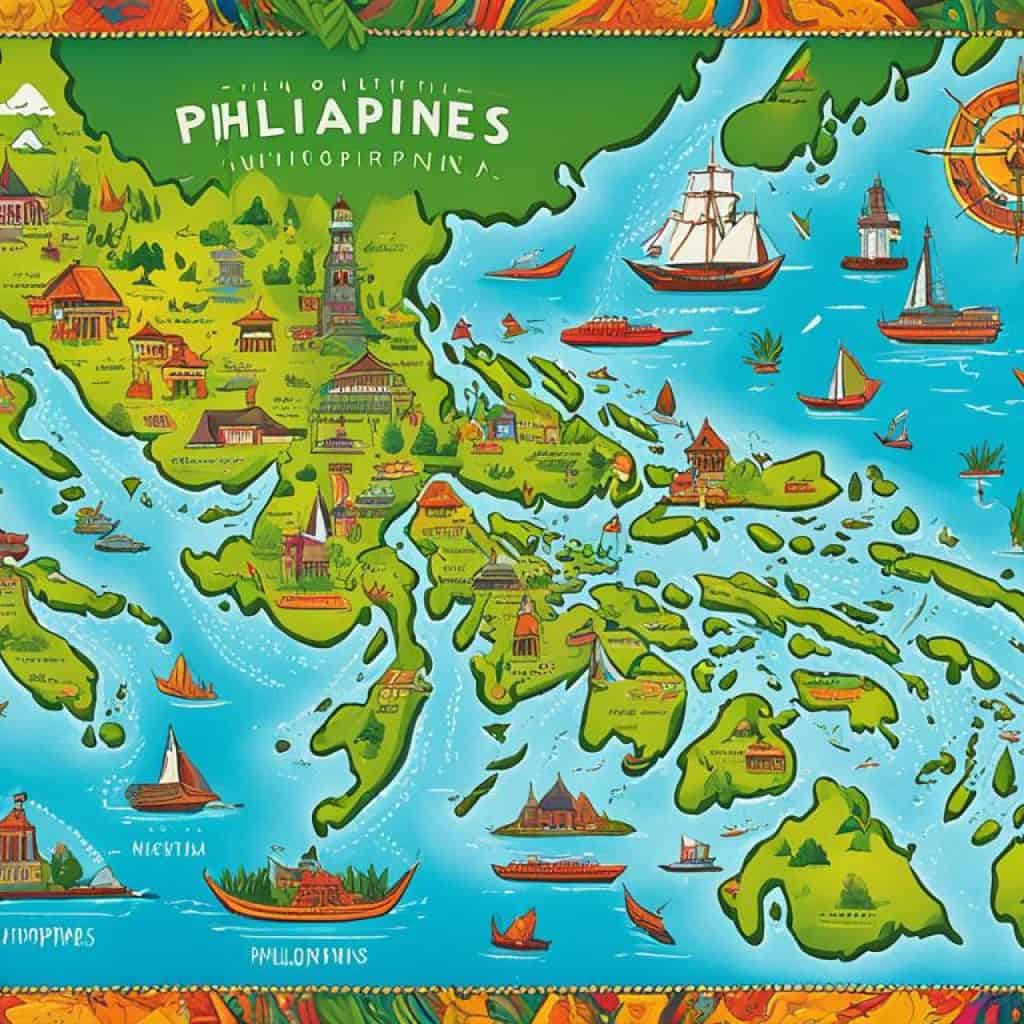
Minority Languages in the Philippines
In addition to the major languages and regional dialects, the Philippines is also home to various minority languages spoken by specific ethnic groups. These languages play a crucial role in preserving the unique cultural heritage and identities of these communities, contributing to the linguistic diversity of the Philippines.
Palawan Languages
The Palawan languages are spoken by the indigenous Palawan people in Palawan province. These languages, including Palawano and Molbog, reflect the rich cultural traditions and history of the Palawan community.
T’boli Language
The T’boli language is spoken by the T’boli tribe in Mindanao. This language holds deep significance for the T’boli people, as it is intertwined with their artistic expressions, such as music, dance, and weaving.
Ivatan Language
The Ivatan language is spoken by the Ivatan people residing in the province of Batanes. This language is an essential part of the unique cultural identity of the Ivatan community, reflecting their close connection to nature and traditional practices.
Agta Language
The Agta language is spoken by the Agta tribe in Luzon. It is characterized by its complex structure and phonetic features, representing the rich linguistic heritage of the Agta people.
These minority languages in the Philippines are an integral part of the country’s linguistic tapestry, and their preservation is crucial for maintaining cultural diversity and fostering a deeper understanding of the unique traditions and customs of different ethnic groups.
Influence of Spanish and English on Philippine Languages
The linguistic landscape of the Philippines has been shaped by the historical influence of both Spanish and English due to colonial rule. Each language has left its mark on Philippine languages, contributing to their richness and diversity.
Spanish Influence on Philippine Languages
During the Spanish colonial period, Spanish became the official language of the Philippines. This had a profound impact on Philippine languages, particularly in terms of vocabulary. Many Spanish loanwords were incorporated into Filipino and other regional dialects, adding a distinct Spanish flavor to the local languages.
“Spanish influence on Philippine languages is evident in numerous loanwords that have become an integral part of daily vocabulary,” explains linguist Dr. Maria Garcia. “Words like ‘libro’ (book), ‘pluma’ (pen), and ‘mesa’ (table) are just a few examples of Spanish loanwords widely used in Filipino.”
English Influence on Philippine Languages
When the Philippines came under American colonial rule, English became the official language and played a significant role in various domains, including education, government, and media. English loanwords started to enter Filipino and other Philippine languages, reflecting the influence of the English language.
“English influence on Philippine languages goes beyond loanwords. It has shaped the syntax, grammar, and usage of the language,” explains Dr. Angela Tan, a linguistics professor. “English has become deeply ingrained in the fabric of communication in the Philippines, and its impact can be seen in the linguistic choices of Filipinos.”
Creole Languages in the Philippines
The influence of Spanish and English on Philippine languages has also given rise to creole languages, such as Chavacano. Chavacano, spoken primarily in the Zamboanga Peninsula and parts of Mindanao, is a Spanish-based creole language with significant influences from the local Philippine languages.
“Creole languages like Chavacano are fascinating examples of language contact and evolution,” says Dr. Roberto Santos, a language historian. “They showcase the blending of Spanish, local languages, and indigenous language features, resulting in a unique linguistic heritage that represents the cultural diversity of the Philippines.”
The influence of Spanish and English on Philippine languages demonstrates the dynamic nature of language and its ability to adapt and evolve in response to historical and cultural circumstances. These influences continue to shape and enrich the linguistic landscape of the Philippines today.
Language Policy and Official Languages in the Philippines
The Philippines has a well-defined language policy that acknowledges Filipino as the national language and English as an official language. The Commission on the Filipino Language is responsible for regulating Filipino and ensuring its development and propagation as a standard form of communication.
Filipino, derived from Tagalog, serves as a lingua franca that unifies Filipinos from different ethnolinguistic backgrounds. It plays a vital role as a means of communication and expression, fostering a sense of national identity and unity.
While Filipino is widely used and understood throughout the country, it is important to note that the Philippine government mainly operates in English. English is widely used in government institutions, education, media, and business, highlighting its importance in various domains of Philippine society.
“Language is a powerful tool that connects people, preserves culture, and facilitates understanding. The recognition of Filipino as the national language and English as an official language in the Philippines reflects the nation’s commitment to linguistic diversity and effective communication.”
In addition to Filipino and English, the Philippines recognizes the other regional languages as official auxiliary languages in their respective regions. However, specific languages are not specified, granting flexibility and inclusivity to the linguistic landscape of the country.
| Language | Language Status |
|---|---|
| Filipino | National Language |
| English | Official Language |
| Regional languages | Official Auxiliary Languages in respective regions |
The language policy in the Philippines aims to strike a balance between promoting a national language that represents the cultural diversity of the country and recognizing the importance of English as a global language. This linguistic framework enables Filipinos to effectively communicate both within their communities and with the international community.
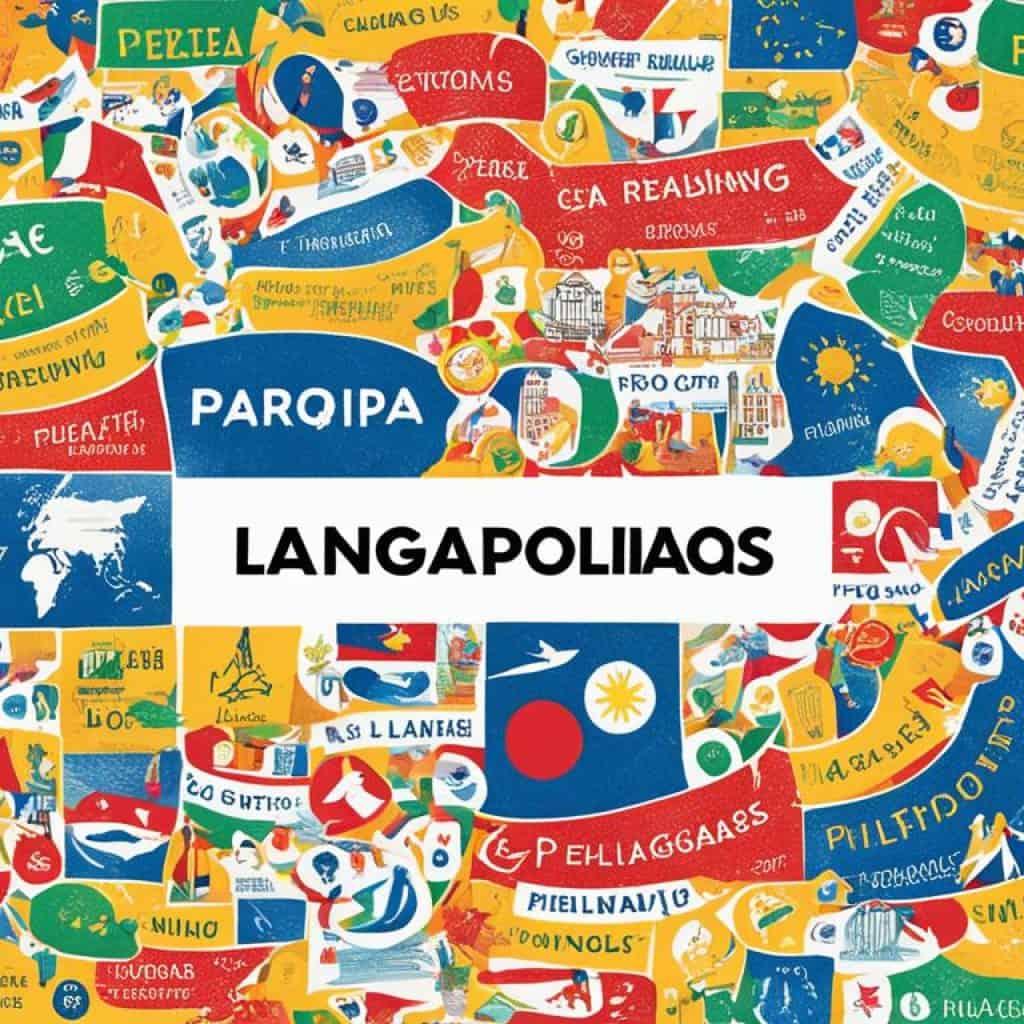
Commission on the Filipino Language
The Commission on the Filipino Language is a government body responsible for developing, enriching, and promoting Filipino as the national language of the Philippines. It ensures the standardization and usage of Filipino in various domains, including education, media, literature, and public administration.
- Developing and publishing dictionaries, grammar guides, and language references for Filipino
- Conducting research on the evolution and development of Filipino
- Promoting the appropriate usage of Filipino in formal and informal contexts
- Collaborating with educational institutions to integrate Filipino in the curriculum
- Preserving and promoting Filipino as a vital aspect of national culture and identity
The Commission on the Filipino Language plays a crucial role in the continuous development, standardization, and preservation of Filipino, ensuring that it remains relevant and accessible to all Filipinos.
Importance of Language Diversity in the Philippines
The language diversity in the Philippines holds immense cultural significance and plays a crucial role in preserving the rich cultural heritage of various communities. It serves as a reflection of the unique traditions, beliefs, and identities of the country’s diverse ethnic groups.
Indigenous languages, in particular, are of great importance in maintaining the cultural diversity of the Philippines. These languages are deeply intertwined with the customs, knowledge systems, and traditional practices of indigenous communities. Preserving these languages is vital for the continuity of cultural heritage and the transmission of traditional knowledge from one generation to another.
Efforts are being made to revitalize and promote the use of indigenous languages in different domains, including education, to prevent their loss. Language revitalization programs and initiatives focus on teaching indigenous languages to younger generations, ensuring that these languages remain alive and vibrant.
“Languages are not simply a means of communication, they embody the history, stories, and wisdom of a people, representing their unique perspective of the world. By preserving and revitalizing indigenous languages, we preserve the diversity and richness of our cultural heritage.”
Language diversity in the Philippines not only serves as a cultural treasure but also contributes to the overall richness and tapestry of the nation. It showcases the country’s unique identity as a melting pot of languages and cultures.
By recognizing and valuing language diversity, we embrace the cultural heritage of the Philippines and foster a deeper understanding and appreciation for the different communities that make up the nation.
| Key Points | Details |
|---|---|
| 1. Cultural Significance | Language diversity reflects the unique traditions, beliefs, and identities of various ethnic groups in the Philippines. |
| 2. Preservation of Indigenous Languages | Preserving indigenous languages is crucial for maintaining cultural diversity and continuity of traditional knowledge. |
| 3. Language Revitalization Efforts | Efforts are being made to revitalize and promote the use of indigenous languages in education and other domains to prevent their loss. |
| 4. Contribution to Cultural Tapestry | Language diversity in the Philippines contributes to the overall richness and cultural tapestry of the nation. |
Language diversity in the Philippines is not simply a linguistic phenomenon; it encompasses the intangible cultural heritage and the complex web of interconnectedness between language, culture, and identity.
Image:
Language Education in the Philippines
Language education in the Philippines is essential for individuals to effectively communicate and engage with various communities within the country and globally. The educational system in the Philippines promotes bilingual education, with Filipino and English serving as the primary languages of instruction. This approach not only enables students to acquire proficiency in both languages but also fosters a sense of national identity and cultural unity.
Bilingual education in the Philippines recognizes the importance of Filipino, also known as Tagalog, as the national language. It is regulated by the Commission on the Filipino Language and serves as a lingua franca that connects people of different ethnic backgrounds. By learning Filipino, students gain a deeper understanding of the country’s cultural heritage and can effectively communicate with individuals from various regions.
English, as an official language in the Philippines, plays a significant role in education, government, media, and business. English proficiency is highly valued and provides individuals with a competitive advantage in the global job market. Through English medium instruction, students develop language and communication skills that enhance their academic and professional opportunities, enabling them to engage with a broader international community.
In recent years, the Philippines has implemented a mother tongue-based multilingual education (MTB-MLE) program to further enhance language learning. The MTB-MLE program recognizes the importance of preserving and developing indigenous languages. It utilizes a student’s mother tongue as the medium of instruction during the early years of basic education, creating a strong foundation for learning Filipino and English while simultaneously supporting the maintenance and revitalization of indigenous languages.
By integrating the learning of multiple languages, the Philippine education system acknowledges the cultural and linguistic diversity of the country. This approach not only assists in fostering language proficiency but also cultivates cultural awareness and respect for different ethnic groups and their traditions.
Evidence of the Benefits of Bilingual Education:
Bilingual education has numerous benefits for students, including:
- Enhanced cognitive abilities and problem-solving skills
- Improved linguistic and cross-cultural awareness
- Expanded opportunities for academic and career advancement
- Increased cultural sensitivity and appreciation
- Strengthened social connections and communication skills
Importance of Language Learning:
“Language learning is not only about acquiring communication skills; it is a gateway to understanding different cultures, fostering meaningful connections, and embracing our shared humanity.”
Language learning plays a crucial role in personal, educational, and professional development. It equips individuals with the tools to engage with diverse cultures, communicate effectively, and expand their horizons. In the context of the Philippines, language learning is essential for fostering cultural understanding, promoting national unity, and preserving the linguistic heritage of various communities.
| Advantages of Language Education in the Philippines | Examples |
|---|---|
| Bilingual proficiency | Students gain proficiency in both Filipino and English, enabling them to communicate effectively in various settings. |
| Promotion of cultural unity | Language education fosters a sense of national identity and cultural unity among students. |
| Preservation of indigenous languages | The mother tongue-based multilingual education program supports the preservation and development of indigenous languages. |
| Enhanced communication skills | Language learning equips individuals with essential communication skills for academic, personal, and professional success. |
| Global competitiveness | Proficiency in Filipino and English positions individuals for success in the global job market. |
Overall, language education in the Philippines plays a vital role in equipping individuals with the necessary linguistic skills, cultural understanding, and global competencies. By embracing bilingual education and promoting the multilingual development of students, the Philippines celebrates its language diversity while preparing individuals for a future that is both globally connected and culturally enriched.
Historical Factors and Language Development in the Philippines
The development of languages in the Philippines has been influenced by various historical factors.
During the Spanish colonial rule, which lasted for more than three centuries, the Spanish language played a significant role in shaping the linguistic landscape. Spanish became the official language and the lingua franca during that time, impacting the vocabulary and structure of Philippine languages. Spanish loanwords and grammatical elements were incorporated into Filipino and other regional dialects, leaving a lasting impact on their development.
The period of American colonial rule brought about the dominance of English in various domains, including education, governance, and media. English replaced Spanish as the official language and became widely used throughout the country. English loanwords and expressions became integrated into Filipino and other Philippine languages, further influencing language dynamics.
“The historical influence of Spanish and English colonial rule on Philippine languages cannot be overstated. These foreign influences have shaped the vocabulary, grammar, and even pronunciation of our languages. The result is a unique linguistic tapestry that reflects the historical ties and cultural exchange between the Philippines and these colonial powers.” – Dr. Maria Cruz, Linguistics Professor
Language policies in different periods have also played a role in the development and recognition of Filipino as the national language. The recognition of Filipino as the national language and the development of its standardized form were important linguistic milestones. Filipino, which is based on Tagalog, became the medium of instruction in schools and is widely spoken and understood by the majority of Filipinos.
Despite the dominance of Filipino and English, the Philippines has maintained the recognition and promotion of regional languages. Different regions in the Philippines have their own distinct languages and dialects, which are recognized and used in local government, education, and media.
The historical factors of Spanish and American colonial rule, along with the language policies implemented in different periods, have shaped the linguistic diversity and richness of the Philippines.
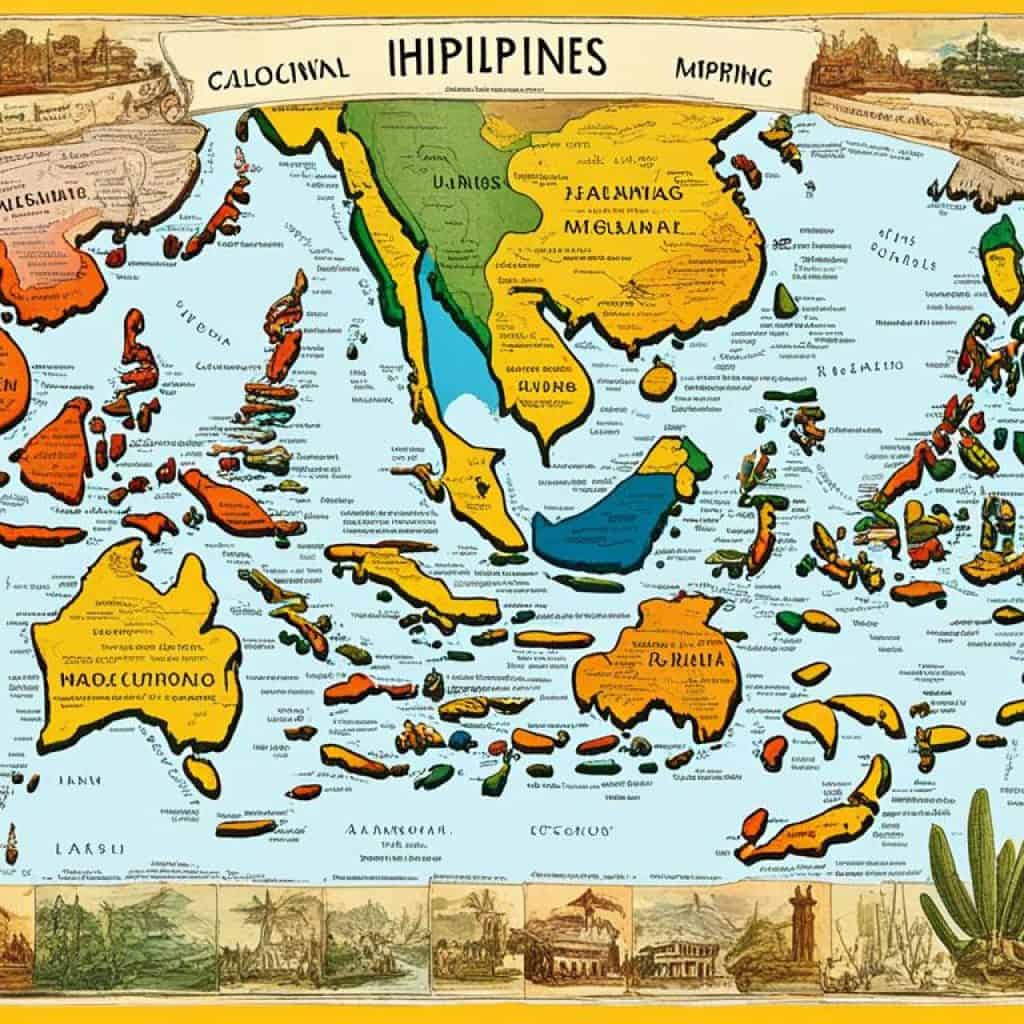
Linguistic Challenges and Language Revitalization Efforts in the Philippines
The diverse linguistic landscape of the Philippines faces various challenges, including language endangerment caused by urbanization, migration, and globalization. The rich indigenous languages of the country are at risk of disappearing if immediate action is not taken to preserve and revitalize them. To counter this issue, language revitalization programs, language documentation initiatives, and community-led efforts are being implemented.
The importance of preserving indigenous languages cannot be emphasized enough. These languages are not only the carriers of unique cultural knowledge but also serve as vital sources of identity and heritage for different communities. Recognizing the significance of language diversity, the government and various organizations have come together in a collaborative effort to safeguard and revitalize indigenous languages in the Philippines.
“Preserving our indigenous languages is crucial in maintaining the cultural tapestry of the Philippines. These languages encapsulate our traditions, history, and sense of identity. By revitalizing them, we ensure the continuity of our cultural heritage for generations to come.”
To achieve these goals, language revitalization programs focus on creating language learning materials, organizing language classes, and promoting the use of indigenous languages in education and other domains. Language documentation initiatives aim to preserve endangered languages through the systematic recording of linguistic data, including oral histories, traditional stories, and songs.
Community-led efforts play a fundamental role in language revitalization by involving local communities in language preservation activities. These efforts strive to create language nests, where children learn their native languages from elder speakers, ensuring intergenerational transmission of knowledge.
The Role of Language Revitalization Programs
Language revitalization programs are instrumental in preserving and revitalizing indigenous languages in the Philippines. These programs focus on:
- Developing language learning materials and curricula
- Organizing language classes and workshops
- Supporting language documentation and linguistic research
- Creating digital resources and language preservation websites
- Collaborating with native speakers and communities
Through these efforts, indigenous languages are being given the attention and resources they need to thrive. Language revitalization programs acknowledge the value of linguistic diversity and the crucial role it plays in preserving cultural heritage.
| Language Revitalization Efforts | Organizations |
|---|---|
| Aklat Kurumustahan: A literacy program that promotes reading and writing in indigenous languages | Department of Education – Philippines |
| Mother Tongue-Based Multilingual Education (MTB-MLE) Program: Incorporating indigenous languages in early education | Department of Education – Philippines |
| Training of native speakers as language teachers and language materials developers | Local communities and indigenous organizations |
| Language preservation websites and digital resources | Various universities and linguistic research institutions |
Language revitalization efforts in the Philippines play a vital role in preserving linguistic diversity and safeguarding the cultural heritage of indigenous communities. By recognizing the importance of preserving indigenous languages, the Philippines takes crucial steps towards fostering a society that values and celebrates its linguistic and cultural richness.
Language as a Reflection of Cultural Diversity in the Philippines
Language in the Philippines is not merely a tool for communication; it serves as a reflection of the country’s cultural diversity, representing the intangible cultural heritage of its communities. Each language spoken throughout the archipelago carries with it a wealth of unique expressions, practices, and beliefs, forming an integral part of the country’s rich cultural tapestry.
Moreover, language acts as a marker of identity, connecting individuals to their cultural roots and heritage. It serves as a unifying force, fostering a sense of belonging and solidarity among members of different ethnic groups. When Filipinos speak their native languages, they are not only expressing themselves but also reaffirming their cultural heritage and asserting their distinct identities.
The cultural significance of language is evident in the diverse range of languages and dialects spoken throughout the Philippines. From major languages such as Filipino and English to regional dialects, indigenous languages, and minority languages, each reflects the distinct traditions and customs of various ethnic communities. These languages encapsulate the profound wisdom, knowledge, and values passed down through generations, serving as vessels that preserve and transmit cultural heritage.
“Language is deeply intertwined with the intricacies of culture. It is not merely a means of communication but a gateway to understanding, appreciating, and celebrating cultural diversity.”
It is through language that Filipinos connect with their ancestors, accessing the deep reservoirs of wisdom and tradition that have shaped their collective identities. The ability to communicate in one’s native language not only preserves cultural heritage but also strengthens intergenerational bonds, fostering a sense of pride and belonging among younger generations.
To further appreciate the cultural significance of language in the Philippines, consider the following table:
| Language | Region/Community | Number of Speakers |
|---|---|---|
| Tagalog | Manila and surrounding provinces | Approximately 22 million |
| Cebuano | Cebu, Bohol, and parts of Mindanao | Approximately 21 million |
| Ilocano | Ilocos Region | Approximately 7 million |
| Hiligaynon | Western Visayas | Approximately 8 million |
| Various Indigenous Languages | Indigenous communities across the Philippines | Varies |
The table presents some of the major languages spoken in the Philippines, representing the diversity and distribution of languages across different regions and ethnic communities. This diversity further emphasizes the importance of language as a reflection of cultural diversity in the country.
The cultural significance of language in the Philippines cannot be overstated. It is through language that the nation’s cultural heritage is preserved, celebrated, and transmitted to future generations. By recognizing and embracing the linguistic diversity of the Philippines, we honor the multitude of traditions, beliefs, and values that shape our vibrant nation.
Conclusion
The Philippines is a country that prides itself on its rich language diversity, with a plethora of languages, dialects, and creole varieties spoken throughout its regions. From major languages like Filipino and English to regional dialects, indigenous languages, and minority languages, the linguistic landscape of the Philippines reflects its cultural heritage and history.
Language serves as a powerful tool for connecting communities, preserving cultural traditions, and sustaining the intangible cultural heritage of different ethnic groups. It is through language that individuals express their identity, beliefs, and values, and by recognizing and celebrating the language diversity in the Philippines, we can honor the cultural tapestry of the nation.
Cultural heritage preservation plays a vital role in maintaining the languages spoken in the Philippines. By embracing and valuing the different languages, we ensure that the unique traditions, customs, and knowledge embedded within them are passed down through generations. Language revitalization efforts, along with the promotion of bilingual and multilingual education, are instrumental in safeguarding the linguistic diversity of the Philippines.
In conclusion, the language diversity in the Philippines is not only a testament to the varied ethnic groups that inhabit the archipelago but also a reflection of the country’s cultural richness. By preserving and promoting these diverse languages, we contribute to the preservation of cultural heritage and foster a sense of unity and appreciation among Filipinos. Embracing and celebrating language diversity is key to preserving the uniqueness and identity of the Philippines.
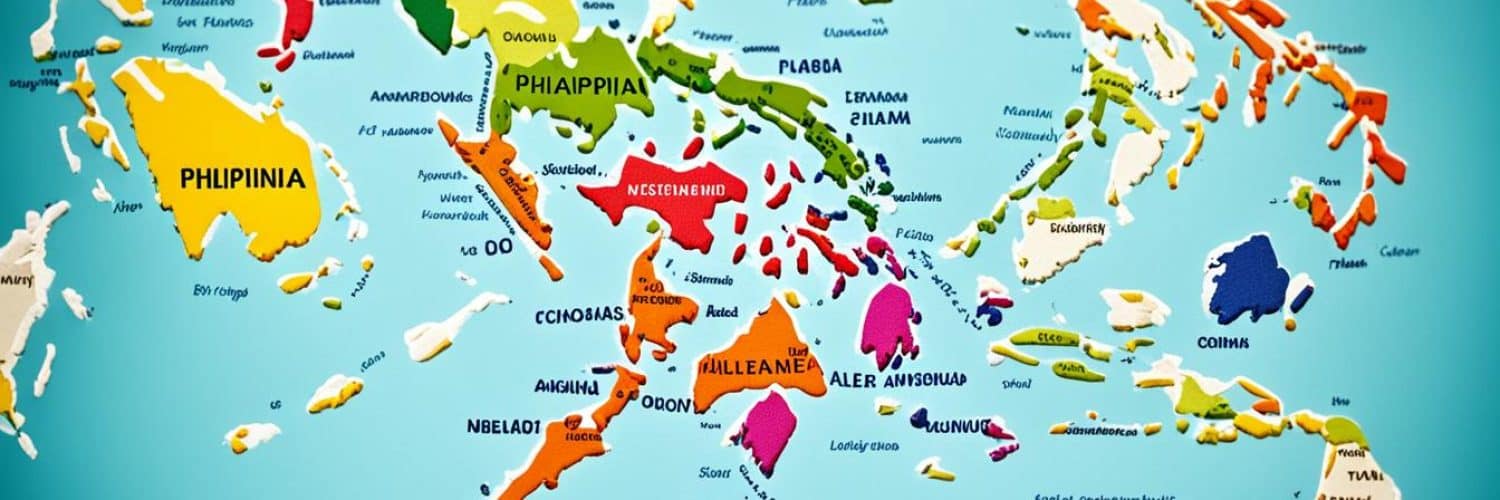
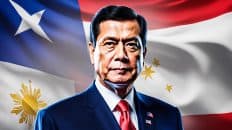












Add comment